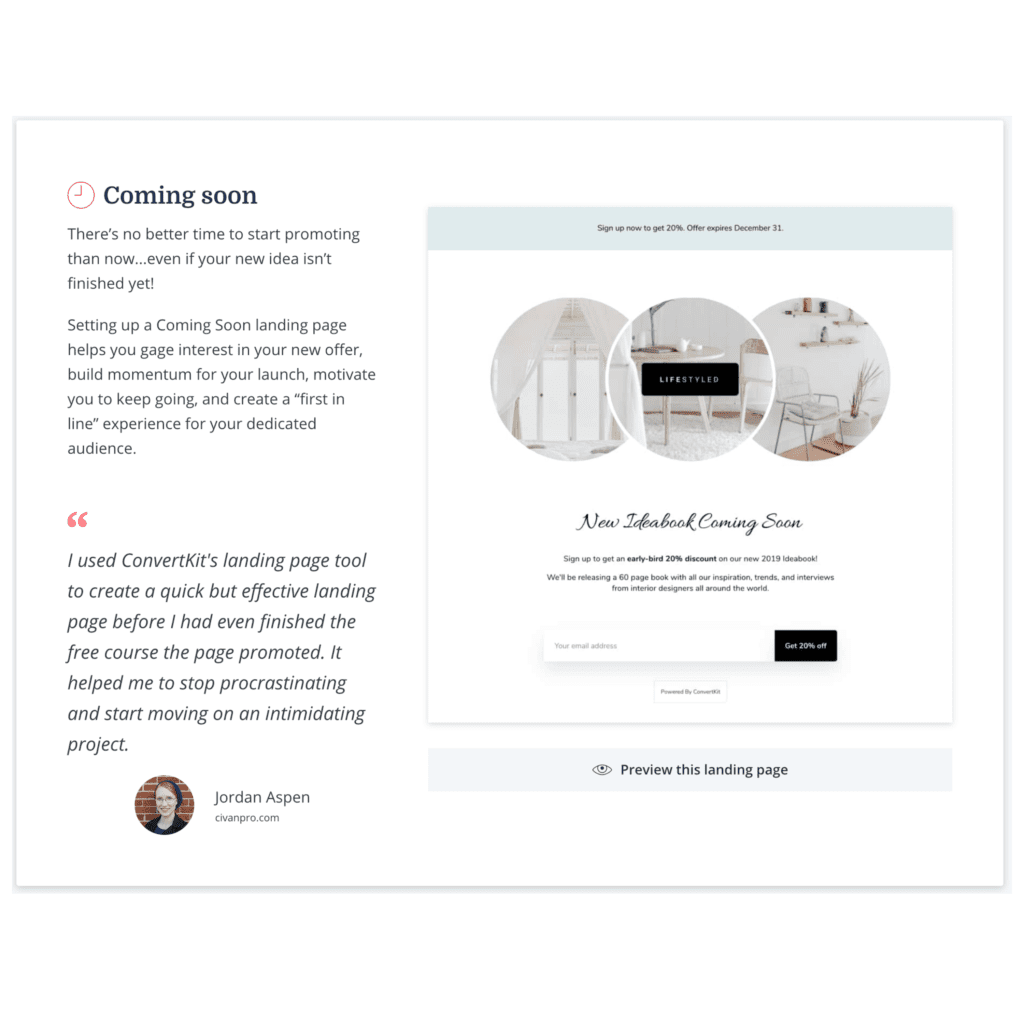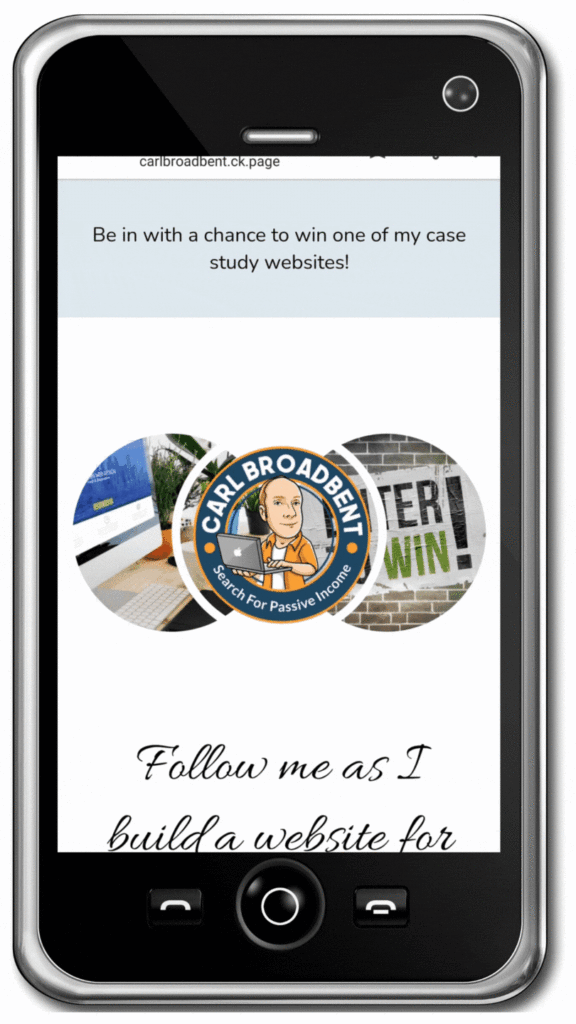
Are you website-free but looking for a smart way of presenting your brand online?
If the answer is “yes”, you could really benefit from using landing pages as part of your strategy. I’ve found that these stand-alone, non-website pages (complete with URL) really help me take a more focused and targeted approach to engage my website visitors and building my email lists.
But don’t you need a website to publish pages online?
I used to think that too, but as I have found out you can almost identical pages online, one of which is a webpage and the other a landing page.
To get to the bottom of this were going to take a look at the difference between a landing page and a website.
Both are powerful marketing tools that work great on their own and even better together. Let’s get into this.
What is a website?
A website is a collection of individually addressed and interlinked web pages that are filed and accessible under a single domain name.
Websites are the bread and butter of the internet and are produced by individuals or organizations to display information online.
So, what is a landing page?
Good question. A landing page is firstly a single webpage that is published online. It is designed to stand alone and be interacted with individually.
Though it may be linked to a website it is not navigable.
Landing pages display focused information on a particular topic and are designed to prompt the page visitor to complete a specific action on the page.
So if websites and landing pages both consist of some form of webpage what is the difference?
This is a common question and probably confusion between website pages and landing pages often means that neither type of page is utilised optimally.
However, the key distinction to remember is a website and a landing page have different purposes.
You are using them for different reasons and each page type should perform differently with different results.
Static website pages are by nature, more general and informative.
Of course, a blog is dynamic as it updated regularly with new and varied posts.
But a general web page is all about inviting visitors in to learn about and explore your brand.
I use web pages, particularly the home page as an introduction to what the website is about, the business or brand and its values.
No-obligation, hassle-free info is provided like services provided or contact details.
If you take a look around my site, you will see that that is what my pages are doing.
They are my way of welcoming you to the site and enabling you to learn a little bit about me.
With landing pages, it’s all about focus.
Landing places are one of the few places on the internet where you can unashamedly get to the point.
They are highly engineered and well-targeted sales or lead-generation machines. After all, look at the alternative names:
- lead capture page
- opt-in page
- static page
- single property page
- destination page
- splash page
- capture page
- lead magnet page
- gift page
- free offer page.
- squeeze page
A landing page that does what it is meant to do should generate, enquiries, email subscribers, orders or any other specific action you want your visitors to take.
Convinced? Click here to get your FREE Convertkit and start building a landing page today.
Conversion is key!
Because landing pages are so targeted and focused, they are effective.
They can be used for discrete time-limited campaigns or offers and always lead visitors to a singular goal or clear call to action.
In building landing pages, you are completely focused on the bottom line and helping your visitor make their decision.
Distractions are kept to a minimum and the page layout, messaging and design is similarly honed to get the desired opt-in.
Because the landing pages are used for a singular purpose you can create many of them each targeting a different part of your audience.
The varied landing pages will resonate with specific groups and provide you with an enhanced conversion rate.
Just look at these mouthwatering stats for landing page conversions:
- Across all industries, landing pages have an overall conversion rate of just under 10%.
- Sign-up landing page forms have conversion rates of up to 23%, with forms that have 3 fields having the highest conversion rate.
- Being upfront about visitor concerns like data privacy will boost conversion by up to 80%.
Website pages and landing pages are like different ends of a funnel.
A homepage has a lot of work to do as it has to speak to the widest possible audience to try and engage them.
Just like the broad opening of a funnel. This is a big job as many visitors may not have come across the site before and need to be brought up to speed.
Messaging on these types of pages is very generic and the pages are often busy with lots of links to more focused areas of the site.
With this type of broad approach, a targeted marketing message or call to action can get completely lost.
Page visitors are easily distracted by links and information, diluting any promotional messages.
On the other hand, a landing page is like the opposite narrow end of a funnel as it has no distractions but doggedly drives the visitor to the opt-in.

A closer look at what landing pages can do for you.
Having discrete web pages that convert more of your traffic is a win-win for your affiliate marketing.
After all, it takes the pressure off your website pages and the creation of innumerable random URLs to support specific campaigns and agendas that can affect the structure and performance of your site on the major search engines.
Other key benefits of landing pages include:
- More direct and personalized interaction with your audience: Because landing pages are hyper-focused you can achieve much more direct communication with site visitors who find your page. As the audience has been segmented and targeted through content and keywords that they are searching for your landing page is more likely to resonate with them.
- The ability to undertake A/B testing to enhance conversion rates: By testing different landing page designs you can zone in on the design features and content that resonate with your audience.
- Landing page design is uncluttered: You don’t need to manage the distractions of a sidebar or outbound links.
- You can have separate online communications from your website: Landing pages mean you do not need to cumber your website with every single marketing message.
- Landing pages allow you to market online: This is the ideal arrangement for YouTube or social media pros who have a large following but do not want to have the hassle of running a whole website. Hosted landing pages are a fuss-free way to direct traffic to an online opt-in.

So, when should I be using a website?
Don’t worry, websites are not obsolete. Websites are the ideal ecosystem for users to explore your brand.
Use your website to let visitors know about you, your mission, and stay up to date and informed with quality content on your blog.
You can set the tone of how you will relate to site visitors ongoing and of course provide contact information and your other online hangouts like social media.
A well-structured and carefully optimized website will be more visible to users searching for a diverse range of long-tail keywords relating to your content meaning you can grow your traffic as your website grows.
When is a landing page the best solution?
As I mentioned above landing pages are all about targeted marketing, so if you have hyper-specific messages and a call to action you should be using your landing pages.
If you use PPC advertising or Facebook ads, linking the ad to a dedicated landing page will boost relevance and conversions meaning that you get much better value for money from your paid advertising.
Landing pages are the ideal solution for presenting great offers and other lead magnets you have created like e-books, webinars or coupon codes.
Have you heard of microsites?
Microsites are a happy medium between a full-blown website and landing pages.
They consist of no more than a handful of landing pages which are all centred around a highly specific message or value proposition.
If you have something big to share with your audience, perhaps a new product or service that you want to promote in a focused way, a microsite may be needed to provide visitors with all the information and answers needed for them to complete your desired call to action.
They are particularly useful for time-sensitive offers that involve a sale.
Turbocharge your affiliate marketing and use Landing Pages
More and more I am finding that having the ability to segment and funnel my audiences means that I can have a much more focused approach to growing opt-ins and sales across my websites.
On my journey of growing my email subscriber list, I have found the creation of targeted landing pages has boosted my subscriber numbers. Even better,
I can build professional, fully-branded custom landing pages on my ESP without laying a finger on my websites.
How do I do this?
Read my article “Do you need a website to create a landing page?”.
Who do you use Carl?
I use the FREE landing pages provided by Convertkit. They have dozens to choose from and can be text or video/image bases pages.

They are super quick and simply to set up and like I say… Free once you purchase their Email Software.
The good part about free landing pages from companies like convertkit is that you can experiment and play around with campaigns without worrying about setting up hosting and websites.
Competitions, Giveaways and Promos can be setup within minutes to track performance and collect data and emails.

